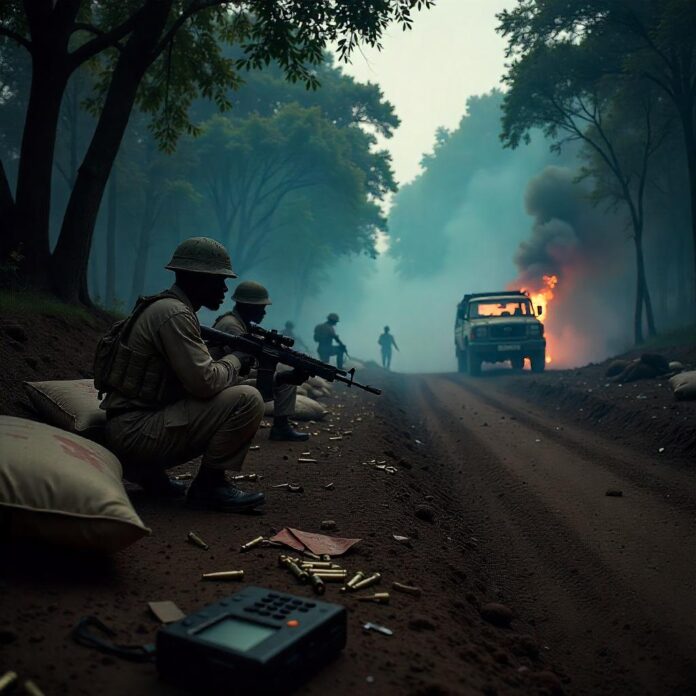The crackle of gunfire echoes through Katsina’s forests as joint security forces execute lightning-fast responses to bandit incursions. On June 18, 2025, a coordinated raid in Kurfi-Safana saw troops intercept bandits who had just attacked Rahamawa village, rustled 22 cattle, and left farmer Alhaji Danmalam mortally wounded. In the ensuing firefight at Dutsen Falale, 12 bandits were neutralized, five AK-47 rifles recovered, and all stolen livestock returned to grieving families. This victory came at a cost: one vigilante slain, one soldier wounded, and Danmalam succumbing to injuries.
What makes this operation emblematic of Katsina’s new approach? Three shifts stand out: hyper-local intelligence where Community Watch Corps members—farmers by day, sentinels by night—provided real-time coordinates of bandit routes through the rugged terrain; cross-force integration where army units, police tactical teams, and vigilantes shared ammunition, vehicles, and medical support during the 5-hour engagement; and asset denial where beyond neutralizing threats, forces systematically confiscated motorcycles (a bandit lifeline) and destroyed forest camps—like the Shawu Forest raid that seized 40 bikes and ₦15,260 in illicit cash.
Tactical Impact of Recent Kinetic Operations (May-July 2025)
Location: Kurfi-Safana | Bandits Neutralized: 12 | Key Recoveries: 5 AK-47s, 22 cattle | Community Impact: Vigilante martyrdom; livestock returned
Location: Shawu Forest | Bandits Neutralized: 21 | Key Recoveries: 40 motorcycles, PKT machine gun | Community Impact: Disrupted supply chains
Location: Danmusa Corridor | Bandits Neutralized: Surrendered kingpins | Key Recoveries: 16 hostages freed | Community Impact: Immediate civilian relief
Yet these operations aren’t unilateral. Success hinges on villagers whispering coordinates to commanders—a trust forged through visible protection, not empty promises.
The Amnesty Gambit: When Bandits Choose Peace
Beneath the acacia trees of Danmusa, a surreal scene unfolded on June 14, 2025: Notorious terror kingpins Kamulu Buzaru and Abdulkadir Black handed over rusted AK-47s like ceremonial artifacts. In exchange, they freed 16 hostages—including a seven-month pregnant woman—and vowed to “renounce evil” before community elders. Their surrender broker, ex-bandit Adamu Alero, implored crowds: “Shun negative words… Their children deserve schools, not stigma.”
This disarmament ritual reveals Katsina’s controversial carrot-and-stick calculus: zero negotiations with active killers where Commissioner Bala Zango’s mandate is absolute—no ransom talks, no prisoner swaps during attacks; rehabilitation pathway where surrendered bandits receive vocational training (farming, tailoring) and their children gain school placements—breaking cycles of inherited violence; and tribe-centric mediation leveraging respected Fulani leaders like Alero to convince kinsmen that “banditry burns our future.”
But scars run deep. When 60-year-old Mallam Ibrahim—whose son was killed by bandits in 2023—saw Black walk free, he spat: “They smell our fear again.” This rage underscores Katsina’s tightrope walk: Can reintegration work where past amnesties failed? Security analyst Dr. Hawa Musa notes: “The 2020 deals collapsed because we rewarded ringleaders with cash, not consequences. Today’s model demands public contrition—a first step toward restorative justice.”
Frontline Realities: Vigilantes, Grief, and Unbreakable Spirit
Visit Funtua’s emergency clinic at dawn. You’ll find women with shrapnel wounds from farm ambushes, children malnourished because fields lie fallow, and vigilantes like 24-year-old Bello stitching homemade bulletproof vests from scrap metal. “We fight with machetes against machine guns,” he shrugs, showing a photo of his martyred cousin—one of 137 vigilantes killed since January 2025.
The human tapestry of this conflict reveals agonizing patterns: economic asphyxiation where in Charanchi, maize harvests dropped 90% after bandits poisoned wells—spiking grain prices 300% in Katsina city markets; generational trauma where schoolteacher Aisha Yusuf records children’s drawings: “90% sketch guns before houses”; vigilante valor where when bandits raided Ruwan Godiya, baker Umar joined night patrols despite no formal training. His widow now burns his uniform weekly: “To stop ghosts visiting.”
Yet resilience flickers. In Shawu, women weave taliya (traditional mats) from bullet shell casings. Farmers near Niger’s border plant thorny Gabaru hedges as natural barriers. “We won’t flee ancestral lands,” declares grandmother Rabi Musa, pounding millet near scorched ruins. “Our sweat feeds this soil.”
Crossroads: Can Neutralization Become Peace?
Katsina’s gains remain fragile. Bandits now slip across Zamfara’s border within hours of raids—exploiting Nigeria’s 1,497km porous boundary with Niger where 10 border posts lack even jeeps or radios. Governor Radda’s administration faces four critical tests: border drones or bust where military requests for thermal cameras and surveillance drones remain unfunded—forcing troops to track footprints like colonial-era scouts; jobs over jail where the National Counter-Terrorism Center (NCTC) urges vocational centers in Danmusa: “Teach animal husbandry to ex-rustlers; convert weapons into ploughshares”; vigilante formalization where Community Watch Corps demands standardized kits, trauma counseling, and monthly stipends—currently paid in “patriotism and prayers”; mining mafias where intelligence reports link bandit weapons to Zamfara’s illegal gold mines—requiring financial forensics to sever funding streams.
Former Army Chief Lt.-Gen. Faruk Yahaya prescribes deeper reform: “Train junior officers in mission-command doctrine. Let sergeants make battlefield decisions when bandits strike—don’t await orders from Abuja!”
The Unseen Battles After Bullets
Katsina’s war won’t end at the barrel of a gun. True bandit neutralization demands healing farms and forests, not just seizing weapons. When ex-bandit Kamilu Buzaru embraced the Danmusa elder who once cursed his name, something shifted: reconciliation tasting of sweat and tears, not politics.
As Commissioner Zango declared: “Lay down arms, and we’ll lift you up. But raise a gun? We’ll bury you in the dust you plunder.” For Katsina’s orphans and widows, justice remains a flickering mirage. Yet in surrendered weapons piling up like grim sculptures, in vigilantes singing hymns during night patrols, the most potent weapon emerges: stubborn, unkillable hope.
“Peace is not the absence of war, but the presence of tomorrow.”—Graffiti near Faskari military checkpoint


